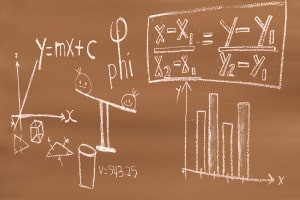Coordinate geometry is an essential branch of mathematics and usually assists us in locating points in a plane. Acquire the knowledge to understand the connection between algebra and geometry by using graphs, lines, curves and formulas to calculate special shapes’ areas. For example, we teach you how to use Heron’s formula to calculate the area of a triangle without necessarily calculating the angles or other distances in the triangle. Study the concept of locus and coordinate geometry related to circles and parabolas. We will uncover the parameters of regular polygons and the formula used to calculate the area of a regular polygon. We unwrap the formula used to calculate the volume of a rectangular solid. If the segment joining the centres of the circles of a cylinder is perpendicular to the planes of the bases, the cylinder is a right circular cylinder. We will briefly illustrate the formation of the circular cylinder and explain how to calculate its volume.
This course emphasises developing critical thinking skills related to logical reasoning and argument. Roughly, we can say that a line is an infinitely thin, infinitely long collection of points extending in two opposite directions. When we draw lines in geometry, we use an arrow at each end to show that it extends infinitely. We give you a step-by-step guide on how to derive the formula for calculating the distance between a point and a line. We outline the relationship between two parallel lines. The way to make the slope the ‘most opposite’ is to flip it and make it negative. This will help you prove that the length of the slope of opposite reciprocals is the same. Discover the difference between 2-D and 3-D geometry. Uncover how to calculate the distance between two points in space and find their midpoint.
Finally, you will be required to use different technological tools and manipulatives to discover and explain much of the course content, such as translation, reflection, dilation and composition of transformation and the properties preserved in them. In line with the geometry theorem, this course shows you how to solve the linear systems of equations both graphically and algebraically. We illustrate the formation of a locus, summarise the fundamental locus statements and explain the concept of locus and coordinate geometry related to circles and parabolas. In this course, you will learn about the lines of symmetry found in quadrilaterals, triangles and a circle. This course teaches you how to calculate the angle of rotation and half-turns using succinct examples. We present all the necessary mathematical tools for complex reasoning and solving problems in the sciences, technology, engineering and many skilled trades and professions. Why delay? Enrol today and become a master in coordinate geometry.
What You Will Learn In This Free Course
View All Learning Outcomes View Less All Alison courses are free to enrol, study, and complete. To successfully complete this Certificate course and become an Alison Graduate, you need to achieve 80% or higher in each course assessment.
Once you have completed this Certificate course, you have the option to acquire an official Certificate, which is a great way to share your achievement with the world.
Your Alison certificate is:
- Ideal for sharing with potential employers.
- Great for your CV, professional social media profiles, and job applications.
- An indication of your commitment to continuously learn, upskill, and achieve high results.
- An incentive for you to continue empowering yourself through lifelong learning.
Alison offers 2 types of Certificate for completed Certificate courses:
- Digital Certificate: a downloadable Certificate in PDF format immediately available to you when you complete your purchase.
- Physical Certificate: a physical version of your officially branded and security-marked Certificate
All Certificate are available to purchase through the Alison Shop. For more information on purchasing Alison Certificate, please visit our FAQs. If you decide not to purchase your Alison Certificate, you can still demonstrate your achievement by sharing your Learner Record or Learner Achievement Verification, both of which are accessible from your Account Settings.











 Avg. Hours
Avg. Hours  Contains Video
Contains Video  CPD Accredited
CPD Accredited 
 Total XP:
Total XP: 
 Knowledge & Skills You Will Learn
Knowledge & Skills You Will Learn 







